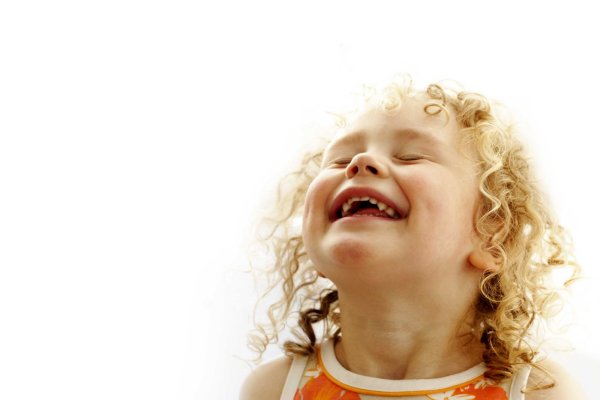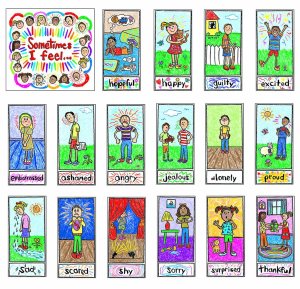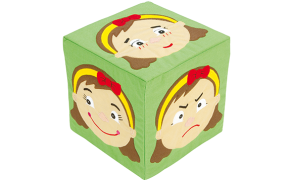
Social-emotional literacy can be defined as “the ability to recognize, label, and understand feelings in one’s self and others.” It is a prerequisite skill to emotional regulation, successful interpersonal interactions, & problem solving, and an incredibly important skill acquired in early childhood due the broad impact it has on child’s ability to relate successfully to others. Unfortunately, emotional literacy often takes the backseat to a focus on more obvious language, literacy & academic skills in the preschool years. Perhaps it shouldn’t. Research shows that teaching children emotional vocabulary from an early age can have a significant and lasting impact on a child’s development.
The Happy-Sad Phenomenon
Have you ever noticed when you ask a young child how he or she feels, they most often will tell you, “Happy” or “Sad.” Children often miss the subtle gradations of feelings that occur in-between happy and sad because they have not developed a vocabulary or solid understanding for those emotions. According to work conducted by Dr. Gail Joseph & Dr. Phillip Strain in conjunction with The Center for Social and Emotional Foundations for Early Learning, a large and more complex vocabulary of feelings “allows children to make finer discriminations between feelings; to better communicate with others about their internal affective states; and to engage in discussions about their personal experiences with the world.” Isn’t this what we want for our children? So, how do we help support the development of these foundational skills? It’s actually quite simple.
Social-Emotional Teaching Strategies
Parents and educators can help children build a more complex social-emotional vocabulary through play, book reading, and special activities.
1. Books
It will come as no surprise to hear that books are an excellent way to expose young children to a rich array of language & concepts, including social-emotional vocabulary. Parents & educators can help build a child’s social-emotional vocabulary by labeling feelings depicted by characters in books already on their child’s bookshelf, or choose books written with the specific purpose of helping children learn about feelings. Just taking a moment to ask your child, “How do you think he/she feels?” after an event takes place in the story, or labeling the facial expressions of story characters is an easy & effective way to help your child build social-emotional vocabulary.
2. Feelings Activities
Plan special activities and games that reinforce understanding & use of feelings words.
 “I Feel…” Poster
“I Feel…” Poster
Create a feelings poster in your home or in the classroom that depicts a variety of facial expressions. Take a moment in the morning to check in on how your child is feeling as she is brushing her teeth or eating breakfast. Check in again when she gets home from school. When your child is talking about what happened during her day at preschool, encourage her to tell you how situations & events made her feel, by pointing to a facial expression and using the appropriate word (i.e., “How did you feel when Jack knocked your block tower down?”). You can create a feelings poster yourself or purchase a ready-made poster. The key is to build in new words & pictures gradually. Talk about each new feeling as you add it to your child’s poster. Draw your child’s attention to the facial expression. Talk about a time he or she felt that way. Talk about what he or she can do to deal with that emotion. Communication is key.
 Feelings Dice
Feelings Dice
Create a set of feelings dice with your child by gluing pictures of faces depicting various emotions on each side of a small box. Children can toss the dice, label the feeling, & describe a time they felt that way.
Sing a Feelings Song
Modify “If You’re Happy and You Know It…” to include other feelings words, and sing about what you can do when you feel that way. For example, “If You’re Sad & You Know It, Hug a Friend.”, or “If You’re Angry & You Know It, Take a Break.”
Mirror, Mirror on the Wall
Use the mirror to play one of these games with your child as he or she is brushing teeth in the morning or getting ready for bed.
3. Recognizing Feelings in Others & Self
It sounds simple, but another amazingly effective way to teach children social-emotional vocabulary is explicitly labeling a child’s various affective states as they go about their daily activities & routines. If you’ve spent any time around a toddler, you are quite familiar with the quick and drastic fluctuations that can occur in their emotional state throughout the day. Labeling an emotion in the midst of a temper tantrum is not the best approach, but you can label your child’s emotions before the situation escalates and help her problem solve ways to calm down (i.e., “You are angry. Do you want to color or read a book until your body is calm?”).
Parents can also model emotional regulation skills for children by verbalizing their own feelings & the actions they plan to take to calm down or cope with certain feelings (i.e., “Mommy is frustrated. I dropped the cup and made a big mess. I’m going to take some deep breaths, then go clean up the mess I made.”).
Learn More
The Center on the Social and Emotional Foundations of Early Learning (CSEFEL), Vanderbilt University is an excellent resource for families & professionals, providing a variety of tools to support social-emotional development in early childhood.
Building Blocks Speech, Language & Literacy provides free tips & resources for parents & professionals on our blog-Babble On. Take a moment to sign-up and we’ll send you an e-mail notification when new information is posted so you can stay up-to-date.